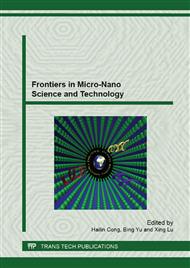[1]
X. Wang, J. Zhuang, Q. Peng, Y. Li. A general strategy for nanocrystal synthesis, Nature. 437(2005) 121-124.
DOI: 10.1038/nature03968
Google Scholar
[2]
Y. Xia, X. Xia, Y. Wang, S. Xie. Shape-controlled synthesis of metal nanocrystals, MRS Bull. 38(2013) 335-344.
DOI: 10.1557/mrs.2013.84
Google Scholar
[3]
Y. Zhu, T. Mei, Y. Wang, Y. Qian. Formation and morphology control of nanoparticles via solution routes in an autoclave.J. Mater. Chem. 21(2011)11457-11463.
DOI: 10.1039/c1jm11079a
Google Scholar
[4]
Z. Gong, Y. Yang. Recent advances in the research of polyanion-type cathode materials for Li-ion batteries. Energ & Environ Sci. 4 (2011) 3223-3242.
DOI: 10.1039/c0ee00713g
Google Scholar
[5]
M. K. Devaraju, I. H. Hydrothermal and solvothermal process towards development of LiMPO4 (M=Fe, Mn) nanomaterials for lithium-ion batteries. Adv. Energy Mater. 2(2012) 284-297.
DOI: 10.1002/aenm.201100642
Google Scholar
[6]
J-M. Tarascon. Key challenges in future Li-battery research. Phil. Trans. R. Soc. A. 368(2010) 3227-3241.
DOI: 10.1098/rsta.2010.0112
Google Scholar
[7]
P. G. Burce, B. Scrosati, J-M Tarascon. Nanomaterials for rechargeable lithium batteries. Chem. Int. Ed. 47 (2008) 2930-2946.
DOI: 10.1002/anie.200702505
Google Scholar
[8]
P. Poizot, S. Laruelle, S. Grugeon, L. Dupont, J-M. Tarascon. Nano-sized transition-metal oxides as negative-electrode materials for lithium-ion batteries. Nature, 407(2000) 496-499.
DOI: 10.1038/35035045
Google Scholar
[9]
Y. Yu, C. Chen, J. Shui, S. Xie. Nickel-foam-supported reticular CoO-Li2O composite anode materials for lithium ion batteries. Angew. Chem. Int. Ed. 44 (2005)7085-7089.
DOI: 10.1002/anie.200501905
Google Scholar
[10]
G. Binotto, D. Larcher, A.S. Prakash, R. Herrera Urbina, M.S. Hegde, J-M. Tarascon. Synthesis, characterization, and li-electrochemical performance of highly porous Co3O4 powders. Chem. Mater. 19 (2007) 3032-3040.
DOI: 10.1021/cm070048c
Google Scholar
[11]
L. Dupont, S. Laruelle, S. Grugeon, C. Dickinson, W. Zhou, J-M. Tarascon. Mesoporous Cr2O3 as negative electrode in lithium batteries: TEM study of the texture effect on the polymeric layer formation.J. Power Sources. 175 (2008)502-509.
DOI: 10.1016/j.jpowsour.2007.09.084
Google Scholar
[12]
M.V. Reddy, T. Yu, C. Sow, Z.X. Shen, C. T. Lim, G.V.S. Rao, B.V.R. Chowdari. α-Fe2O3 nanoflakes as an anode material for li-ion batteries. Adv. Funct. Mater. 17(2007) 2792-2799.
DOI: 10.1002/adfm.200601186
Google Scholar
[13]
W. Zhang, X. Wu, J. Hu, Y. Guo, L. Wan. Carbon coated Fe3O4 nanospindles as a superior anode material for lithium-ion batteries. Adv. Funct. Mater. 18 (2008) 3941-3946.
DOI: 10.1002/adfm.200801386
Google Scholar
[14]
X. Wang, Y. Li. Monodisperse nanocrystals: general synthesis, assembly, and their applications. Chem. Commun. (2007) 2901-2910.
Google Scholar


